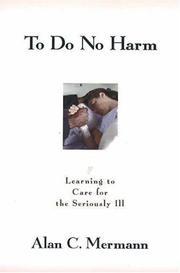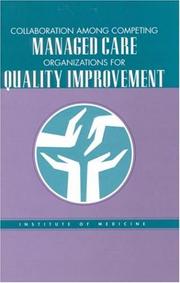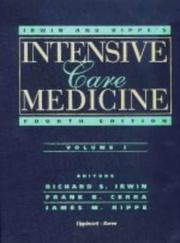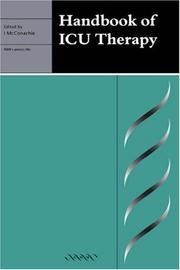| Listing 1 - 10 of 847 | << page >> |
Sort by
|
Book
Year: 1999 Publisher: [Place of publication not identified] : Agency for Healthcare Research and Quality (US),
Abstract | Keywords | Export | Availability | Bookmark
 Loading...
Loading...Choose an application
- Reference Manager
- EndNote
- RefWorks (Direct export to RefWorks)
Book
Year: 1999 Publisher: Cambridge, Mass. National Bureau of Economic Research
Abstract | Keywords | Export | Availability | Bookmark
 Loading...
Loading...Choose an application
- Reference Manager
- EndNote
- RefWorks (Direct export to RefWorks)
This paper examines the role of medical care in improving health and compares that value of better health produced by medical care with the costs of that care. Valuing medical care requires measuring the health of the population. We start by developing a measure of the nation's health capital -- the dollar value of health a person will have over the course of their remaining life. We estimate health capital empirically using data on the length of life, the prevalence of adverse conditions for those alive, and the quality of life conditional on having an adverse condition. For a newborn in 1990, we estimate health capital at about $3 million, while for the elderly, health capital is nearly $1 million. Health capital has increased greatly over time -- by roughly $40,000 to $50,000 per decade. Comparing the change in health capital with the increase in medical spending, we estimate that, for most plausible assumptions, increased medical technology has been worth its cost. In our preferred specification, only about 30 percent of the improvement in health capital in the past 40 years would need to result from medical care advances for the improvement of medical technology to justify its cost. While we find that on average value of medical technology is high, we discuss other evidence that substantial amounts of medical care is provided in situations where its value is low. We thus suggest a fundamental repositioning of the public debate about medical spending. Traditionally, the question that has been posed in the public sector is: how can society (or the government) limit medical costs so that we can afford medical care in the future on our budget today? Our results suggest that a more appropriate question is: how can we get more of the spending that is valuable but avoid the spending that is not valuable?

ISBN: 1573926663 1573926671 Year: 1999 Publisher: Amherst Prometheus Books
Abstract | Keywords | Export | Availability | Bookmark
 Loading...
Loading...Choose an application
- Reference Manager
- EndNote
- RefWorks (Direct export to RefWorks)
"To Do No Harm is a study of the ways people experience serious and life-threatening illnesses, the types of suffering they endure, and how we can come to understand their lives. Alan C. Mermann describes a course at the Yale School of Medicine that uses patients as teachers for students, helping them learn the impact of disease upon the whole person. He covers suffering in body, mind, and spirit. The book also discusses the hopes and means for a fully realized life for the professional healthcare provider through compassionate care of the sick."--Jacket.
Critically ill --- Terminal care --- Care

ISBN: 0309063868 9786610186105 1280186100 0309592917 0585082413 9780585082417 9780309063869 0309184355 Year: 1999 Publisher: Washington, D.C. : National Academy Press,
Abstract | Keywords | Export | Availability | Bookmark
 Loading...
Loading...Choose an application
- Reference Manager
- EndNote
- RefWorks (Direct export to RefWorks)
Managed care plans (Medical care) --- Managed care programs (Medical care) --- Managed care systems (Medical care) --- Managed health care --- Plans, Managed care (Medical care) --- Programs, Managed care (Medical care) --- Systems, Managed care (Medical care) --- Health insurance --- Medical care

ISBN: 0781714257 9780781714259 Year: 1999 Publisher: Philadelphia Lippincott Williams and Wilkins
Abstract | Keywords | Export | Availability | Bookmark
 Loading...
Loading...Choose an application
- Reference Manager
- EndNote
- RefWorks (Direct export to RefWorks)
Critical Care --- Intensive Care --- Intensive Care Units --- Emergency Treatment --- Critical care medicine --- Intensive Care Units. --- Critical Care. --- Surgical Intensive Care --- Intensive Care, Surgical --- Care, Critical --- Care, Intensive --- Care, Surgical Intensive --- Emergencies --- Care Unit, Intensive --- Care Units, Intensive --- Intensive Care Unit --- Unit, Intensive Care --- Units, Intensive Care --- Intensive care --- Intensive medicine --- Medicine --- Emergency medicine --- Intensive care units --- ICU Intensive Care Units

ISBN: 0511043252 9780511043253 0585257841 9780585257846 1900151782 Year: 1999 Publisher: [Place of publication not identified] Greenwich Medical Media
Abstract | Keywords | Export | Availability | Bookmark
 Loading...
Loading...Choose an application
- Reference Manager
- EndNote
- RefWorks (Direct export to RefWorks)
Critical Care --- methods. --- Critical care medicine --- Intensive care units
Book
Year: 1999
Abstract | Keywords | Export | Availability | Bookmark
 Loading...
Loading...Choose an application
- Reference Manager
- EndNote
- RefWorks (Direct export to RefWorks)
Medical care --- Managed care plans (Medical care) --- Quality control.
Book
Year: 1999
Abstract | Keywords | Export | Availability | Bookmark
 Loading...
Loading...Choose an application
- Reference Manager
- EndNote
- RefWorks (Direct export to RefWorks)
Medical care --- Managed care plans (Medical care) --- Quality control.
Periodical
ISSN: 15390705 Year: 1999 Publisher: Philadelphia, PA : Philadelphia, PA : Nursecom, Inc., Lippincott Williams & Wilkins
Abstract | Keywords | Export | Availability | Bookmark
 Loading...
Loading...Choose an application
- Reference Manager
- EndNote
- RefWorks (Direct export to RefWorks)
Hospice care --- Palliative treatment --- Nursing --- Hospice Care --- Palliative Care
Book
Year: 1999 Publisher: Cambridge, Mass. National Bureau of Economic Research
Abstract | Keywords | Export | Availability | Bookmark
 Loading...
Loading...Choose an application
- Reference Manager
- EndNote
- RefWorks (Direct export to RefWorks)
Many questions about technology growth and development in health care call for a broad-based characterization of technology availability. In this paper, we explore the possibility of producing aggregated estimates of technology availability by constructing an index of technology availability in hospitals. Our index is based on the number of services provided by a hospital, weighted by how rare those services are. We use the index to examine the relationship between managed care and technology availability in hospitals. We find that managed care may have slowed technology growth in the mid 1980s, but in the early 1990s we find little evidence that technology growth in areas with high-HMO market share is any slower than growth in lower market share areas. To the extent that our index captures variation in the costs of new technologies, this finding leaves open the question of whether managed care can help control long term cost growth by slowing technology adoption. We also discuss the general strengths and weaknesses of indices of the type we develop. One concern arises from the considerable variation across individual technologies. We profile several individual technologies and note that conclusions drawn from the aggregated index may not apply to each of the constituent technologies. Nonetheless, this exercise shows that it is feasible to develop and analyze hospital technology indices if aggregated information about technologies is appropriate to the research question.
Medical care, Cost of. --- Managed care plans (Medical care)
| Listing 1 - 10 of 847 | << page >> |
Sort by
|

 Search
Search Feedback
Feedback About
About Help
Help News
News